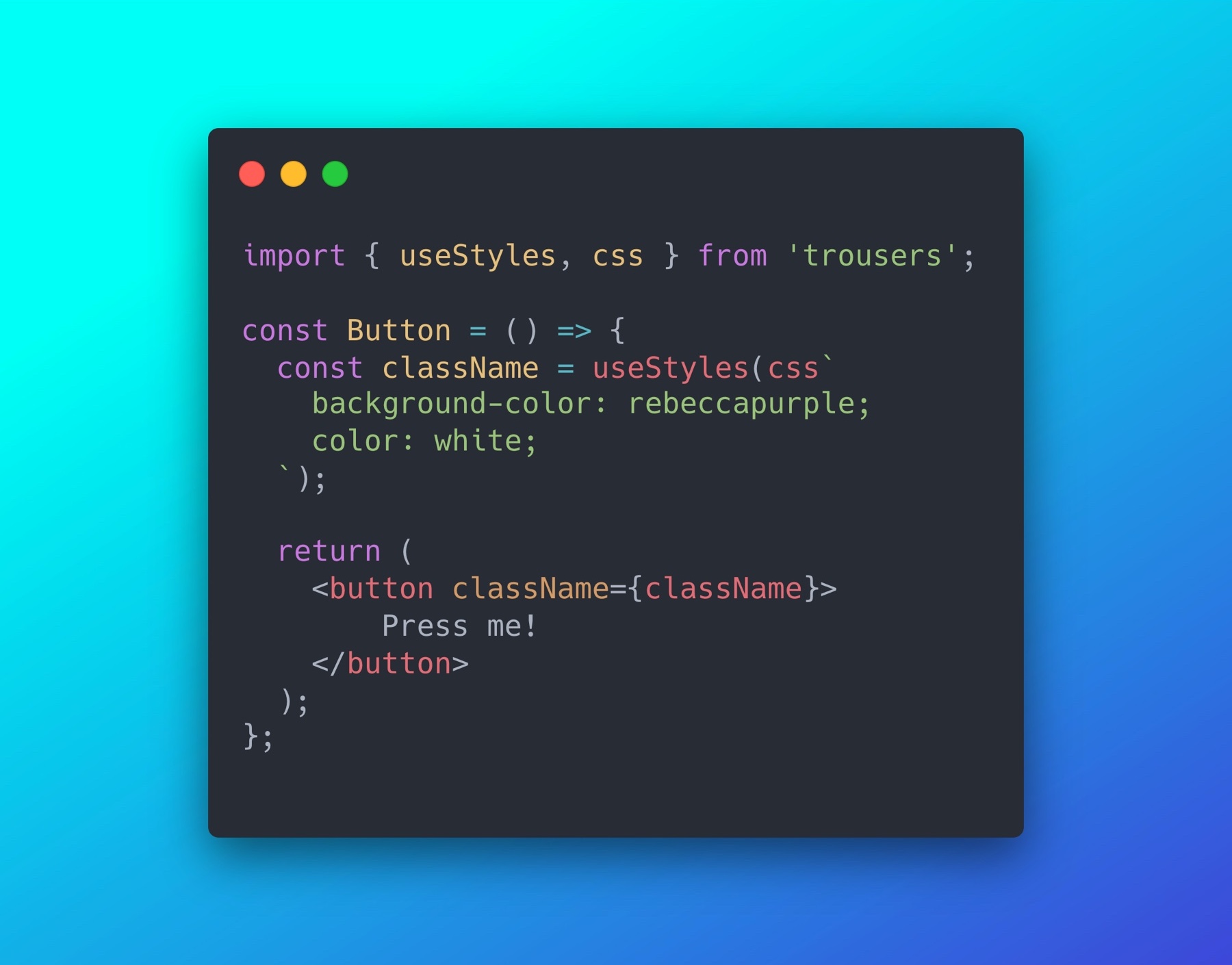danieldelcore / Trousers
Programming Languages
Projects that are alternatives of or similar to Trousers
Trousers 👖
React components are more stylish with Trousers!
Trousers is a hooks-first CSS-in-JS library, designed to help developers author React apps with performant and semantic CSS. It is heavily influenced by the conventions introduced by BEM, borrowing the concept of Blocks (the component), Elements (children nodes) and Modifiers (styles as a function of state). Through this API, Trousers encourages semantic organisation of styles without inadvertently increasing the runtime implications often associated with CSS-in-JS libraries.
Table of Contents
Get started ⚡️
Installation
npm install --save trousers or yarn add trousers
Basic example
A basic purple button:
import { css, useStyles } from '@trousers/core';
const Button = props => {
const className = useStyles(css`
background-color: rebeccapurple;
color: white;
`);
return <button className={className}>{props.children}</button>;
};
export default Button;
Complete example
A themed button with a primary variant:
app/components/button.jsx
import { useStyles } from '@trousers/core';
import styleCollector from '@trousers/collector';
const styles = props => styleCollector('button').element`
background-color: ${theme => theme.backgroundColor};
border: none;
color: ${theme => theme.textColor};
margin: 0 10px;
padding: 10px 20px 14px 20px;
:hover {
background-color: ${theme => theme.hoverColor};
color: rgba(255, 255, 255, 0.8);
}
`.modifier('primary', props.primary)`
background-color: #f95b5b;
color: #ffffff;
:hover {
background-color: #e45454;
}
`;
const Button = props => {
const buttonClassNames = useStyles(styles(props));
return <button className={buttonClassNames}>{props.children}</button>;
};
export default Button;
app/MyApp.jsx
import { ThemeProvider } from '@trousers/theme';
import Button from './components/button';
const theme = {
backgroundColor: 'blue',
textColor: 'white',
hoverColor: 'lightblue',
};
const MyApp = props => {
return (
<ThemeProvider theme={theme}>
<Button primary>How do I look?</Button>
</ThemeProvider>
);
};
export default Button;
Motivation 🧠
Components often require many variations and states to be flexible and truly reusable. Think about a simple Button, it can have variations like primary, secondary, subtle and each variation has it's own states, clicked, hover, loading. But with modern CSS-in-JS libraries it can be hard to represent these variations and states in a way that makes sense to everyone and is repeatable without having to memorise specific syntax.
Consider this example:
const Button = styled.button`
background: ${props => (props.primary ? 'palevioletred' : 'white')};
color: ${props => (props.primary ? 'white' : 'palevioletred')};
margin: 1em;
padding: 0.25em 1em;
border: 2px solid palevioletred;
`;
We have a button with two variants, default and primary. Functionally it works, but semantically it's really hard to see at a glance what color will be applied when it's primary. How would we extend this further, if say, we wanted primary buttons to have a disabled state?
What's more, for every permutation of props, a new class will be created and attached to the <head>. Every class that is created incurs additional runtime cost, this can grow exponentially if you're not careful, resulting in a combinatorial explosion of classnames 💥. Consider a component with 3 variants and 3 possible states, that is 3 x 3 = 9, 9 eventual classes generated for one component. It doesn't scale, but we could take another approach:
const Button = styled.button`
background: white;
color: palevioletred;
margin: 1em;
padding: 0.25em 1em;
border: 2px solid palevioletred;
${props => props.primary && css`
background: palevioletred;
color: white;
`}
}
Now that's more like it! This can be extended and scales to many variations and states.
I think @MadeByMike articulated this perfectly in: CSS Architecture for Modern JavaScript Applications 👌
BEM gave semantic meaning to classnames and one of the biggest unseen values in this was we could immediately transfer our intentions to other developers across teams and even projects. If you know BEM you can look at a classname, e.g.
button--state-successand immediately recognise this as a modifier for a button class.
But there's still a problem, this syntax has to be memorised and there's nothing stopping you from falling back into the previous example. This is where an abstraction can protect us and scale that knowledge across your codebase. This is where Trousers can help 🎉...
Using our style collector you can express these variants and states like so:
import { styleCollector, useStyles } from 'trousers';
const styles = styleCollector('button').element`
// Base styles applied to all buttons
color: white;
`.modifier('primary', props => !!props.primary)`
// A modifier for the primary variant
color: black;
`.modifier('secondary', props => !!props.secondary)`
color: blue;
`.modifier('subtle', props => !!props.subtle)`
color: blue;
`;
const Button = props => {
const classNames = useStyles(styles, props);
return <button className={buttonClassNames}>{props.children}</button>;
};
export default Button;
In this scenario, Trousers will only ever mount 3 classes to the <head> and toggle them on and off using the predicates provided to the style collector. It will only ever mount what it needs so, if a subtle button is never used you wont pay the run-time cost of processing and mounting those styles.
Under the hood, style collectors are simply an array of styles. This opens the door to a lot of possibilites because it is possible to create your own style collectors that suit your specific needs. What if you want a state machine style collector? Or a style collector that accepts objects instead of template literals? You can simply define one and pass it straight into Trouses 😲!
Features ✨
Hooks-first 🎣
Hooks are a (relatively) hot new feature in React, which allows Trousers to access context and state while abstracting the messy details away from the consumer.
Our useStyles hook accepts a name, some props and an instance of styleCollector(). It will then evaluate everything for you and return a human-readable class name, which you can then apply to your desired element.
For example, here we define a style for the button and inner span and apply the resulting classes to their respective elements.
const Button = props => {
const buttonClassNames = useStyles(buttonStyles(props));
return <button className={buttonClassNames}>{props.children}</button>;
};
Composable API 🏗
Trousers is based on a monorepo architecture, meaning that the internals of the repo have been decomposed into a group of smaller stand-alone packages. This allows you to opt-in to features such as SSR, Theming and BEM-style collectors. Doing this will reduce your bundlesizes and tailor (lol) trousers to suit your application.
- @trousers/core: The most minimal version of Trousers
- @trousers/collector: BEM Style collector
- @trousers/server: Tools for SSR
- @trousers/theme: Theming API
- @trousers/theme-css: Theming implemeneted as CSS variables
- @trousers/hash: Simple hashing methods
- @trousers/registry: Style registry
- @trousers/util: Types and utility methods
Otherwise you can use the base Trousers package which is an out-of-the-box composition for the above.
CSS Prop 👩🎤
Trousers supports a css prop, similar to that of emotion and styled-components! This is handy when you want to skip the boilerplate of declaring useStyles hooks in your components and instead just pass style collectors directly to the components you wish to style.
Just remember to import jsx and set it as the pragma at the top of the file.
For example...
/** @jsx jsx */
import { jsx, css } from '@trousers/core';
const Button = ({ children }) => (
<button
css={css`
background-color: #b3cde8;
color: white;
`}
>
{children}
</button>
);
Theme Support 🎨
Theming is achieved via React's Context API, which provides a lot of flexibility. You can even choose to nest themes and present a section of your app in a different way. It looks a little something like this:
import { ThemeProvider } from '@trousers/theme';
const lightTheme = {
primaryColor: 'white',
secondaryColor: 'blue',
disabledColor: 'grey',
};
const darkTheme = {
primaryColor: 'black',
secondaryColor: 'purple',
disabledColor: 'grey',
};
const MyApp = () => {
return (
<ThemeProvider theme={lightTheme}>
<h1>Hello World</h1>
<p>Rest of my app lives here and has access to the light theme!</p>
<ThemeProvider theme={darkTheme}>
<p>This subtree will have access to the dark theme!</p>
</ThemeProvider>
</ThemeProvider>
);
};
When a Trousers component is mounted within a new theme context, it will render new styles and apply them to the component.
You can define how your component handles themes like this:
const buttonStyles = props => styleCollector('button').element`
background-color: ${theme => theme.secondaryColor};
`.modifier(props.primary)`
background-color: ${theme => theme.primaryColor};
`.modifier(props.disabled)`
background-color: ${theme => theme.disabledColor};
`;
Now your component will render different styles based on the context it is mounted in.
Global styles 🌏
Every app needs some form of global styling in order to import fonts or reset native styling, for example using @font-face would be quite challenging to use without access to globals.
Turns out that there's a hook for that, useGlobals:
import React, { useEffect } from 'react';
import { css, useGlobals } from '@trousers/core';
const globalStyles = css`
@font-face {
font-family: MyFont;
src: url('${MyFont}') format('opentype');
}
`;
const App = () => {
useGlobals(globalStyles);
return <h1>Welcome to my website!</h1>;
};
Server side rendering (SSR) 🤖
Server side rendering with Trousers follows a similar approach to styled-components. It works by firstly instantiating a serverStyleRegistry, wrapping your application in a ServerProvider, then passing that registry into the provider as a prop. Then when you render your application to a string with react-dom/server, Trousers will push styles into the style registry. You can then pull the styles from the registry and manually append them to the head of your document.
import React, { FC, ReactNode } from 'react';
import { renderToString } from 'react-dom/server';
import { ServerStyleRegistry, ServerProvider } from '@trousers/server';
import App from './';
const registry = new ServerStyleRegistry();
const html = renderToString(
<ServerProvider registry={registry}>
<App />
</ServerProvider>,
);
// Your styles will be accessible here
const styleTags = registry.get();
Object notation support 📚
If template strings aren't for you it's easy to leverage css as objects.
Simply pass a css compliant object to Trousers.
const classNames = useStyles({
backgroundColor: 'blue';
color: 'white'
})
Custom Style Collectors 🕺
Don't like the style collector API? That's fine, Trousers lets you supply your own! Under the hood a style collector is simply an array of objects which makes it easy to say, build a state-machine style collector.
For example a minimal style collector could look something like this:
import { StyleDefinition, Predicate, Expression } from '@trousers/utils';
import { toHash } from '@trousers/hash';
export default function myStyleCollector(styles) {
return {
get: () => [
{
styles,
hash: toHash(styles.toString()).toString(),
predicate: true,
name: 'custom_prefix--',
},
],
};
}
and use it like this:
import myStyleCollector from './my-style-collector';
const styles = myStyleCollector(`
button {
color: red;
}
`)
...
useStyle(styles);
API Reference 📖
Trousers a monorepo made up smaller packages, each with their own responsibilities. Please see respective packages for API information.
- @trousers/core: The most minimal version of Trousers
- @trousers/collector: BEM Style collector
- @trousers/server: Tools for SSR
- @trousers/theme: Theming API
- @trousers/theme-css: Theming implemeneted as CSS variables
- @trousers/hash: Simple hashing methods
- @trousers/registry: Style registry
- @trousers/util: Types and utility methods
FAQ 🤷♀️
Can't you do this in styled-components and emotion?
This can most certainly be done in styled-components and emotion! They are both great libraries, packed with loads of features. Trousers on the other hand, aims to be a little more simple and opinionated, it urges you to be deliberate about how styles are defined for particular states so that they can be clearer and more maintainable.
What does this have to do with hooks? Can we not compute the classname from a plain-old JS function?
The reason Trousers is a hook was so it could access (consume) the context from within the library, without exposing that implementation detail to the user. Otherwise you would have to wrap or access the context manually and pass it into Trousers. There are also plans on leverage hooks more down the line to enable a few new features.





